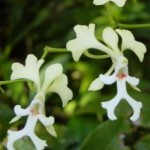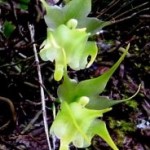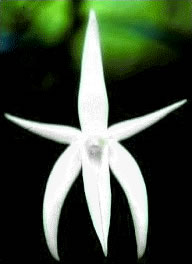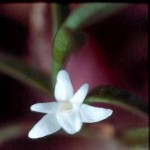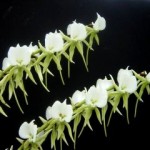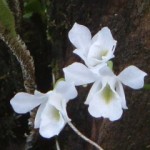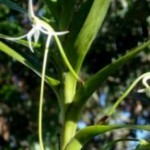Indigenous Orchids
The latest publication on the orchid flora of the Mascarene Islands (Mauritius, Rodrigues, and Reunion) came out in May 2023. It reveals that there are about 165 species of orchids, from 40 different genera recorded on the 3 islands.88 of these species occur in Mauritius but only 7 % of them are indigenous to the island of Mauritius.Many of the Mascarene species are considered to be endangered, due to the loss of their habitat.
Hereunder are some species to be found in the remaining forest reserves:
Cryptopus elatus (Thouars)
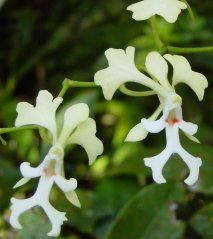
It is one of the most beautiful of all the indigenous orchids of Mauritius and is also the emblem of the Orchid Society of Mauritius. It has an epiphytic growth habit. The leaves are dark green and leathery, 5-7 cm in length and 1.2 -1.6 cm in width. It is found growing at the bottom of small trees or even on the ground. It flourishes at 500-800 m elevations. It produces an abundance of aerial roots.
The inflorescence is 30-60 cm long erect to semi pendulous and carries 7-12 white to greenish- white flowers resembling some sort of insect. The sepals are short and narrow. The petals are larger and deeply lobed, making it most attractive. Like all angraecoids, it has a small spur. In some clones there is a red blush at the base of the lip. The fibrous roots were used by villagers to make nooses to catch fresh water prawns, hence its vernacular name ''liane camaron". The flowers were also used as bridal bouquets in the old days when the forests were full of Cryptopus elatus.
Aeranthes arachnites. (Thouars) Lindl.
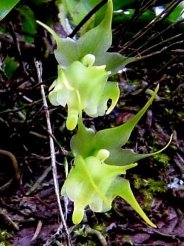
This is known locally as "orchidée poule" (Chicken orchid) because the flower resembles a chicken's beak. It is found growing on rocks and on the base of old trees.
It has practically no stem. The strap-shaped leaves are deep green in colour and are about 20-30 cm long and about 2.5 cm wide. The drooping flower spikes are about 20-30 cm long and very thin. The light green flowers which are about 5 cm long and 3.5 cm wide come from the tip of the spike. It flowers in the summer months. It is still a common plant and not too difficult to find in the forests.
Angraecum mauritianum Frapp
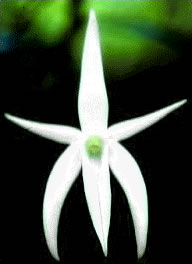
This can probably be called a road-side orchid as it is commonly seen along the road to Plaines Champagne growing on the ground or on fallen trees.
It is never found growing high up on trees. It is rather a small plant and never exceeds 15 cm in height. It branches easily and forms huge clumps. The deep green leaves are about 10-12 cm long and 1 cm wide. The flowers which are star shaped are of a pure white colour and are about 3 cm in diameter and have a 6 cm long greenish spur. They last for about a week and take a yellowish colour before wilting.
Angraecum pectinatum
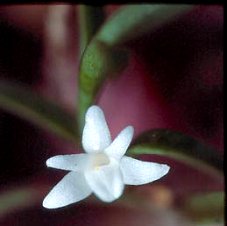
It is perhaps the commonest flower in our forests today. It is a small species growing in clumps on branches or trunks of trees. The small leaves, about 2 cm long, are very thick and deep green in colour. The plant never exceeds 12 cm in height. The white flowers are very small, about 3-4 mm in diameter and last for 2 or 3 days. This orchid grows well in collections and probably because of the proper care, its flowers are then much bigger.
Angraecum eberneum Bory
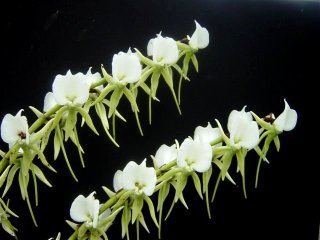
This is a very large and robust plant with large fleshy leaves, usually found growing on rocks, base of tree trunks or even on the ground. Large white flowers are produced on long spikes and are long standing. They are very fragrant at night time.
It is now considered as a critically endangered species.
Beclardia macrostachya (Thou.) A. Rich
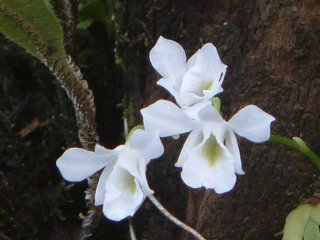
This is one of the prettiest orchids of the island but unfortunately it is now rarely seen in the wild. It resembles a dwarf Angraecum eberneum and the fan-shaped leaves are very flexible.
The flowers about 4 cm in diameter are white with a fairly large lip and yellowish green in the throat. They are long lasting.
Jumellea recta Schltr
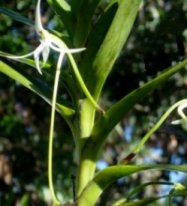
This is the only species of the genus Jumellea which is found growing in Mauritius. It is epiphytic or lithophytic, found growing on small trees or even on the floor of the forest. It is a small plant about 15 cm high with strap-shaped leaves.
The inflorescence is short and is always single flowered. The vertical measurement of the flower is much greater than the horizontal. Pure white in colour with a fairly long spur, the flowers lasts only for a few days. It is very fragrant and is widely used to flavour the local rum; hence the threat of its decimation.


